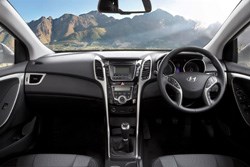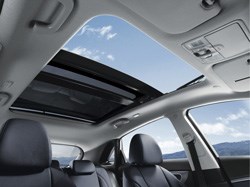Hyundai hunting down the Europeans
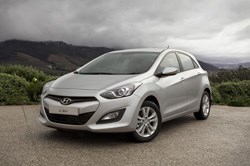
Once again the Korean carmaker has shown that it can produce a vehicle capable of going toe to toe with some of the hardest hitters in the business. The 130 steps into the ring against the likes of VW Golf, Opel Astra and Ford Focus, plus a horde of other competitors in the tightly contested C segment, but even before the battle has commenced the Hyundai already has them beaten in a number of key value fields.
Detailed comparisons are tedious and I am not going to go into a comprehensive model by model overview but anybody looking to buying a vehicle in this class would be unwise not to consider the i30 and to take it for a test drive. Take a careful look at prices and then weigh up the Hyundai's value for bucks compared to the rest and you could be in for a surprise.
Quiet, smooth - and roomy
As with the outgoing range there are two models of the i30 on offer: a 1.6 GLS and a 1.8 GLS, both of which I drove at the Media introduction between Franschhoek and Hermanus, first along the coast from Gordon's Bay to Hermanus and then from there via Caledon, Theewaterskloof and the Franschhoek Pass back to Franschhoek.
My first stint was at the helm of the 1.8 and what impressed me most of all was its well insulated cabin, quiet smooth ride, attractive cabin ambience and the feeling of spaciousness in the living quarters.
The ride is smooth and although the steering still tends to be a tad vague in normal driving mode (a constant criticism aimed at Kia and Hyundai) the i30 now has an impressive advantage over others in this class - the steering 'feel" can now be adjusted between normal, comfort or sport mode with just a thumb click on the steering wheel and that makes quite difference. I tried all three modes and then just left it in Sport Mode which had a pleasant weighty feel.
The 1.8 is a comfortable cruiser but it did feel a little lacking in spirit, particularly on uphill stretches and it would certainly benefit hugely from a bit of more enthusiastic turbo fire-power, particularly up on the Reef where the thin air will take its toll.
The 1.6 auto would be my preferred model of choice. It felt a little livelier and the auto box has a sporty option available at just a small sideways shift of gear selector. You can then drive it tap-tap on the lever or by flicking the flappies on the steering wheel. The time between gears is not exactly Formula One pace but it is quick enough for a bit of fun.
On paper the 110kw/176Nm 1.8 model is considerably faster than both the manual and auto 1.6 models with a 0-100km/h time of 9.7 seconds against the 10.5 of the 1.6 manual and the 11.5 of the 1.6 auto but out on the tar it didn't feel like it at all.
Frugal too
Hyundai also claims the 1.8 is almost as frugal a fuel sipper at 6.5 litres/100km as the 1.6 manual at 6.4 litres/100km. The auto model is slightly thirstier at 6.8 litres/100km.
The ride quality of all three models is a pleasant blend of comfortable-smooth and stable-confident. In fact, if anything the i30 feels a bit too light at times although it doesn't waft, float or lean even when pushed relatively hard through the bends. The fact that the chassis is fairly rigid obviously also plays a role in its confident behaviour. The i30 is also armed with Motor Drive Power Steering (MDPS) that delivers varying degrees of power assistance, depending on surfaces and driving conditions.
Overall the underpinnings now work together better than previous Hyundais, particularly the outgoing i30.
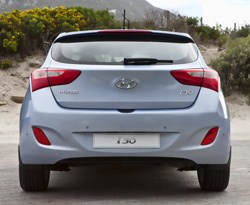
The new-generation i30 is also quite a head turner, having been designed the Hyundai Motor Europe Design Centre in Rüsselsheim, Germany. Like the add on TV says, it's all about nature-inspired "fluidic sculpture" which does sound a bit like esoteric ad agency and marketing dribble but the result in metal is attractive, all the same.
The creative white coats say it's all about flowing lines but irrespective of whether it symbolises clouds, water or lightning, parked at the kerbside it does give the i30 a definite stand-out way about it: perhaps not to everybody's taste (particularly the die-hard followers of boxy shaped vehicles), but difficult to ignore, particularly at a time when so many cars tend to look as though they were cast in the same Plain Jane mould or produced by the same sausage machine.
Build quality is up there among the bets
What certainly add to the car's looks are the generous 16-inch rubber-wrapped alloys on the 1.6 and 17-inchers on the 1.8 model. The latest i30 is a pleasant mix of soft and classy interior and carefully cultivated designer stubble beard on the outside, with a bit of muscle and attitude thrown in as well. It looks energetic with all its macho bulges, wide wheel arches, prominent grille and glaring light clusters and unlike the outgoing model, which tended to be a bit bland, the new i30 demands a second look.
The interior of the i30 is particularly driver friendly and the gauges and dials are clearly visible, intuitive, and easy to reach and fiddle with. I liked the instrument cluster and the on-board computer which make it easy to glance at average fuel consumption, average speed and distance to empty fuel tank. Though still not quite up to the German high standards the overall cabin feel runs close when it comes to perceived build quality
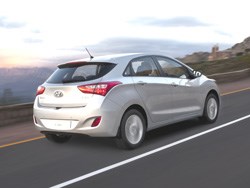
Other cabin kit includes dual-zone climate control, a four-spoke steering wheel with control buttons for the audio system, cruise control and Bluetooth, as well as for the steering settings.
The seats are comfortable and vary from cloth on the 1.6 models to partial leather on the 1.8 version. The GLS also brags with aluminium accelerator, brake and clutch pedals.
Even something for those cold mornings
Both derivatives are equipped with a sound system made up of 4 speakers and 2 tweeters, Bluetooth connection to a cell phone, and connecting sockets for Aux, iPod or USB music input. The sound system also includes the radio and a CD player that can accept MP3 formatted music files. Electric fold-away side mirrors which can also be heated on a cold morning for better visibility are also standard.
The i30 has been awarded the maximum five-star score in Euro NCAP's impact assessment programme and it boasts features such as ESP (Electronic Stability Program), ABS (anti-lock braking system), VSM (Vehicle Stability Management) and Emergency Stop Signal, six airbags as well as front and rear fog lights.
In its latest guise the i30 is more than just a worthy successor to a range which has sold more than 360 000 vehicles since launch. Last year alone more than 115 000 were sold in Europe, to record the highest-ever sales figure for an individual Hyundai model on sale in Europe.
The local marketing suits at Hyundai don't disclose sales figures and projections but the whisper down the passage is that they are expecting sales to be in the region of 250 a month - or even more if they can get stock.
The price tags on all three versions are a bit steep but latest addition to the Hyundai family still represents good value for money.
The models and prices (which include a five- year/150 000km warranty, a five-year/150 000km roadside assistance and a five-year/90 000km service plan) are:
1.6 GLS Manual - R229 900
1.6 GKS Automatic - R243 900
1.8 GLS Manual - R249 900
Hyundai i30 review - CarBuyer
Euro NCAP | Hyundai i30 | 2012 | Crash test
2012 Hyundai i30 new generation - Which? first drive
More by Henrie Geyser: motoring editor
- Ford B-Max in a class if its own - 17 Aug 2015
- Kia's people-carrier goes all swanky - 6 Aug 2015
- RS is a sporty, comfortable commuter - 1 Jun 2015
- Cross-over Kia is a real cheerful Soul - 25 May 2015
- Stylish Renault set to Captur the market - 18 May 2015
About Henrie Geyser: motoring editor
View my profile and articles...
